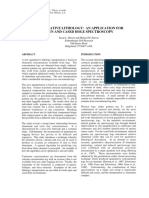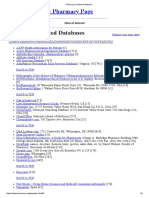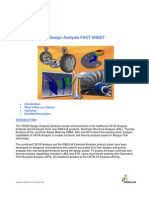Vshale - Potassium - Thorium PDF
Vshale - Potassium - Thorium PDF
Uploaded by
abdoo13Copyright:
Available Formats
Vshale - Potassium - Thorium PDF
Vshale - Potassium - Thorium PDF
Uploaded by
abdoo13Original Title
Copyright
Available Formats
Share this document
Did you find this document useful?
Is this content inappropriate?
Copyright:
Available Formats
Vshale - Potassium - Thorium PDF
Vshale - Potassium - Thorium PDF
Uploaded by
abdoo13Copyright:
Available Formats
SPE 136811
The Correct Shale-Volume Characterization Increases Hydrocarbon
Reserves: Case Study of Cretaceous Formation, Lake Maracaibo, Venezuela
Rodolfo Soto B. / SPE, Digitoil, Duarry Arteaga, Cintia Martin, Freddy Rodriguez / SPE, PDVSA Western Division
Copyright 2010, Society of Petroleum Engineers
This paper was prepared for presentation at the SPE Latin American and Caribbean Petroleum Engineering Conference in Lima, Peru, 13 December 2010.
This paper was selected for presentation by an SPE program committee following review of information contained in an abstract submitted by the author(s). Contents of the paper have not been
reviewed by the Society of Petroleum Engineers and are subject to correction by the author(s). The material does not necessarily reflect any position of the Society of Petroleum Engineers, its
officers, or members. Electronic reproduction, distribution, or storage of any part of this paper without the written consent of the Society of Petroleum Engineers is prohibited. Permission to
reproduce in print is restricted to an abstract of not more than 300 words; illustrations may not be copied. The abstract must contain conspicuous acknowledgment of SPE copyright.
Abstract
Today, natural fracture and/or connected vuggy systems in carbonate reservoirs contribute significantly to hydrocarbon
production.Combining concepts from normal distribution with normalization and soft computing techniques improves
quantification of actual shale volumes for a reservoir with complex stratigraphy and natural fractures. This is especially
important for cases when very few log curves are available to solve a high number of unknown lithologic variables. We
applied our new methodology successfully in the Cretaceous formation, Lake Maracaibo, which is composed primarily of
limestones with some dolomites and siliciclastics (glauconitic sandstones, siltstones, and shales).
It is common to use the standard gamma ray log (SGR) or total contribution from all three elementsuranium (U),
potassium (K), thorium (Th)as an indicator of shale content. The presence of highly radioactive black organic material
and/or natural fractures in the formation results in a big difference from the X-ray diffraction data. This causes an
overestimation of shale volume and therefore affects the original oil in place (OOIP) and reserves. We present a novel
methodology that combines normal distribution and normalization to predict CGR from SGR and deep resistivity, Rt. We
applied the cross correlation technique to validate our methodology, and the model CGR matches the actual CGR very well.
Next, we used the elemental capture spectroscopy (ECS) logs to quantify the actual clay volume (Vsh). Then, we used soft
computing techniques to develop a shale volume model using CGR and Rt as independent variables and the Vsh from ECS as
the dependent variable. Running the model for validation in three wells with ECS achieved a correlation coefficient of 0.9.
The average shale volume using our model is 12.5%, much lower than the former linear shale-volume model, which
averaged 28.4%. This has had a great impact on the OOIP and reserves of our reservoir, as it would for other complex
carbonate reservoirs.
Introduction
Carbonate reservoirs in western Venezuela have great potential for the production of hydrocarbons. However, the extreme
heterogeneity because of their complex lithology and dual-porosity systems has limited their development; for these reasons,
petrophysical evaluation is the key to predicting actual productivity and recovery of hydrocarbon reserves. This requires a
large amount of data to develop models to predict the behavior of the reservoir, optimize their production, and give way to the
characterization, development, analysis and monitoring of their productive lives.
An essential step in petrophysical evaluation is determining the amount of clay present in the formations to calculate the
effective porosity and content of fluids. Normally, the clay content is estimated by laboratory analysis and X-ray diffraction. If
these are not available, the shale volume can be predicted by conventional logs like gamma ray (GR), SP, neutron, resistivity
or, thanks to a mineralogical special log, elemental capture spectroscopy (ECS). This tool measures the concentrations of
minerals such as calcite, gypsum, anhydrite, quarz, and pyrite, and the amount of shale, regardless of gamma ray, SP, and
porosity logs.
Spectral gamma ray (U,Th, K curves) and volume of shale (Vshale) curves from ECS and resistivity logs can be combined
into a powerful tool to recognize clay zones or highly radioactive zones that contain the organic material characteristic of these
formations.
The determination of reservoir quality in terms of petrophysical parameters, lithology identification, porosity, type and
distribution of reservoir fluids, formation permeability, and anticipated water-cut estimates is based mainly on the evaluation
of shale volume since these parameters are all of primary importance to the proper evaluation of reservoir potentiality.
Therefore, quantitatively evaluating a formation requires an accurate estimate of the amount of shale to determine porosity and
SPE 136811
water saturation. This paper discusses a new methodology to develop a confident shale volume model in this kind of
formations and validate it.
Development of a Model to Predict Gamma Ray Without Uranium Effect, CGRns
The gamma ray log is a sum of three radioactive components: uranium (U), thorium (Th), potassium (K).
SGR = a U + b Th + c K (1)
where a, b, and c are the constants of each radioactive component of total GR or SGR.
Counts
It is possible with a spectral gamma ray log to discriminate the contributions of each of these components to get the total
gamma ray, SGR.
Measures of concentrations of thorium (Th), uranium (U) and potassium (K) (Fig. 1) provide petrological information that
helps improve reservoir characterization by:
1. Identifying types and volumes of clays
2. Identifying lithology (matrix components)
3. Identifying geological and sedimentary environments
4. Determining whether a formation is highly permeable, fractured, or with organic matter (separation of thorium and
uranium curve) at high uranium concentrations observed with low concentrations of thorium and potassium.
5. Identifying producing areas, distinguishing a clean site (or radioactive producing zones) from shale.
Gamma Ray Energy, MeV
Fig. 1Spectral gamma ray (SGR) and components K, U, and Th.
According to Koizuml (1988), the normal values of uranium in formations vary from 2 to 6 ppm. However, in areas with high
organic matter content, it is possible to find uranium values that reach 80 ppm, shooting the total gamma ray values, SGR,
above 200API and misinterpreting them as clay zones. If we have a spectral gamma ray (SGR) log, it is possible to correct the
gamma ray from the high uranium content. Then the corrected gamma ray curve is known as CGR. The carbonate Cretaceous
formations are relatively clean formations, with low gamma ray. However, La Luna source rock and some specific zones of
the Cogollo Group (Maraca, Lisure and Apn) display a significant increase radioactivity in the GR log, meaning high content
of clay but not because of high resistivity (>800 ohm-m, Fig. 2).
From an analysis of the gamma ray, spectral components can be found because of anomalous uranium values (>40 ppm);
this indicates organic matter that could be wrongly analyzed as clay. Hence the importance of running the spectral gamma ray
log in each well to be drilled in the Cretaceous formation to determine when a high gamma ray value is associated with clay or
organic matter. In this project, only 10 of the 53 wells have spectral gamma ray. The problem to be solved at this moment is
how to get a CGR model in the wells where we do not have spectral gamma ray.
SPE 136811
WELL UD-779 FM LA LUNA
Fig. 2Example of the high content of uranium (URANn), with high levels of radioactivity (GRn) and true resistivity (RD).
Fig. 3 shows a graph of SGR vs. RD (true resistivity from deep resistivity log) and CGR vs. RD represented by red and blue
points respectively for the Cretaceous in Well UD-779. As you can see, the red dots indicate high values of gamma ray for
high values of resistivity, indicating zones of high organic matter content as discussed above. The blue dots correspond to the
same zones but corrected by uranium or organic material (the effect of uranium radioactivity is eliminated). Therefore, to use
the gamma ray asa clay indicator, we should use the CGR, but not the SGR if we want to avoid overestimating the clay
volumes, which would the OOIP and reserves.
To use the gamma rays log as an indicator, we should use Vshale to predict the gamma ray curve without the effect of
uranium, CGRns. This means that data of normalized total gamma ray, SGRn (region of red dots in Fig. 3), should be moved
to the region of blue dots that correspond to normalized gamma ray without the effect of uranium or organic material, CGRn.
It means for clean zones we should have low gamma ray values with high resistivity values.
CGRn/SGR & RD
CGR: Gamma Ray
without Uranium
SGR: Total Gamma
Ray
CGR/
SGR
RD
Figure 3. Identification of areas with and without effect of uranium or organic matter. Well UD-779.
If we make a graph of SGRN vs. RD with uranium in the z axis (Fig. 4) using a threshold of 6 ppm of uranium, we can
determine the region, with upper and lower limits, of normal behavior not affected by organic matter. We applied this concept
to a well that has a spectral gamma ray log and plotted SGRN and CGRn against RD using the uranium in the z axis for the
SPE 136811
UD-779 well. The CGRn data (in blue) exactly fall into the region bounded by the upper and lower limits of Fig. 4. This chart
could be used to reliably predict uranium in wells where there is no spectral gamma ray.
GRn/RD
URANn
GRn
RD
Fig. 4Upper and lower limits of normal gamma ray (between curves) without effect of organic material.
Another way to eliminate the effect of organic material on uranium is to make a normalization of total gamma ray logs,
SGR, for the wells where we do not have spectral gamma ray curves. That entails using CGRn as a reference curve from one
of the wells with spectral gamma ray and making a normalization of the SGR curves from the other wells that do not have
spectral gamma ray. The obtained curves are called synthetic normalized gamma ray, CGRns. To demonstrate the validity of
this method, we used the CGRn curve for Well UD-779 as reference curve. We took the SGR curve for the same well and
normalized this one with respect to the reference curve, CGRn, to obtain CGRns. Fig. 5 shows how the generated curve,
CGRns, fits perfectly with respect to the reference curve CGRn.
Porcentaje
Total
Percent
of Total
CGR
CGRns, model
CGRn
GRn or SGR
Fig. 5 Normalization of CGRn using CGRn as a reference matches CGRns.
The same procedure was applied first to the rest of the wells that do not have spectral gamma ray, using for all of them the
same reference curve, CGRn from Well UD-779. The correlation coefficient in each case was higher than 0.84. Subsequently,
we plotted the CGRns for each well with respect to RD (Fig. 6). The data fall in the blue region developed in Fig. 4 and the
effects of organic matter on uranium have been eliminated.
SPE 136811
CGRns, Model
CGRns
URANn
RD
Fig. 6Methodology to correct the high values of uranium caused by organic material matches expected region.
Vshale Model Applying Fuzzy Logic
The best way to get a clay model, Vshale, is as follows: Perform petrographic analysis (XRD) of cores; place data obtained
from these tests in depth with the well logs; use the clay indicator logs, such as gamma ray, to develop a nonlinear model. If
x-ray diffraction data are not available, models found in the literature could be used to determine the Vshale from gamma ray
log, but the uncertainty is too high. In our case, we used the mineralogical record of ECS (elemental capture spectroscopy)
because no available petrographic analysis of XRD was available. We generated a graph of Vshale (ECS) vs. normalized
gamma ray without uranium (CGRn), discriminated by the deep resistivity log (RD), using confidence ellipses. This graph
allows visualizing the correspondence between these variables in the multivariate analysis (Fig. 7). In Fig. 7, we can see that
the clay volume, Vshale, applied for this type of complex reservoir carbonate lithology is a nonlinear model, and we applied
fuzzy logic, described in the following section, to develop a confident model.
Developing a Vshale Model using Fuzzy Logic in Conjunction with Spectral Gamma Ray, X-Ray Diffraction,
ECS Log (Mineralogy) and Deep Resistivity (RD)
Conventional (Clavier and Steib) models were calculated according to literature and found an average absolute greater than
300% when compared to Vshale calculated from the ECS logs for each model. We used as input variable CGRns, the gamma
ray corrected by uranium and normalized as discussed above (see Fig. 8). These models predict higher clay content than the
real Vshale, affecting the calculation of porosity and therefore the OOIP and the reserves estimates. To obtain a more reliable
model, we used multivariate statistical techniques and fuzzy logic. For this case the variables were RD and CGRn as
independent variables and Vshale from ECS as the dependent variable. As shown in Fig. 8, the Vshale from the model
(VCLMODEL) developed using fuzzy logic correlated in a remarkable way with real Vshale (ECS). Then we ran the model in
all the wells to calculate the Vshale. The development of this model had a positive impact on the calculation of OOIP and
recovery factor by a factor of 1.25
CGR vs. Vshale ECS
10
>R
D>
50
Vshale, ECS
RD
Linear
Model
50
D>
>R
10
0
20
D>
>R
0
0
10
50
D>
>R
0
20
500
RD >
CGRn
Fig. 7Vshale model (ECS) vs. CGRn; family resistivities by multivariate statistics and confidence ellipse.
SPE 136811
Well VLA-1453st
NO COTEJA
Vcl_Lineal
Vcl_Old
Vcl_Stieber
Vcl_Clavier
Vcl (ECS)
COTEJA
Vcl (ECS)
Vclmodel
Fig. 8Comparison VCLMODEL (fuzzy logic model) vs. Vcl (from ECS log) and literature models vs Vcl (ECS).
Predominant Clay Type Based on Core Gamma and Gamma Ray Spectral
A thorium-potassium methodology using a core gamma or gamma ray spectral log is available for determining the
predominant clay. With this analysis, we can use the parameters measured by the gamma ray spectral tool in the identification
of clay minerals (classification, types, and volume). From those results and the application of the appropriate techniques, we
can obtain reliable models of effective and total porosity. This technique is used when there is limited petrographic analysis
information as such SEM, thin sections (FS), and X-ray diffraction (XRD).
We generated Th (%) vs K (ppm) crossplots to determine the different types of clay; then we coded each one by the lines
of separation of each type of clay to quantify them and see their percentage of contribution. Finally, we found that the
predominant clays are as follows: Lagomar area: kaolinite in 100% clay zones and chlorite in carbonate/sandstones zones; and
Lagomedio area: kaolinite in 100% clay zones and smectite in carbonate/sandstone zones.
Fig. 9 shows the distribution of K and Th from the spectral gamma ray and the percentage of each type of clay for the
VLA-1453_ST well (Lagomar area). Fig. 10 shows that the predominant clay is kaolinite for a zone containing 100% clay
(CGRn> 70 API), while for a clean zone (CGRn <70 API), it is chlorite. The Th is often associated with detrital sediments,
never chemical sediments (limestone and dolomite), so in carbonate reservoirs the Th is an important indicator of clay, and a
graph of K vs Th identifies the predominant type of clay and quantifies the clay volume.
K / Th
SPECTRAL
GR ESPECTRAL
GAMMA RAY
VLA-1453 ST
Ilita
K
Esmectita
Caolinita
Clorita
Th
Fig. 9Crossplot graph K vs. Th of spectral gamma ray for well VLA-1453_st of Lagomar area.
SPE 136811
CGRn<70
CGRn>70
RHOb shale
: 2,64 gr/cc
Fig. 10Percentage of each type of clay in well VLA-1453st of Lagomar area varies between clayey and clean zones.
Running and Validating the Vshale Model
We ran the developed model was run in all wells in the pilot area of the Cretaceous lake and validated it with the mineralogy
log, ECS, from the UD-791 well. Fig. 11 shows how the Vclay or Vshale from the ECS compares with the Vshale from our
model, VCLCRETACEO. There is a very good match (the green and red curves). The correlation coefficient, R2, of the model
is 0.71 (Fig. 12).
Fig. 11VCL_ECS compares well with VCLMODEL in the UD-791 well.
SPE 136811
VCL Model (Fuzzy Logic) vs VCL_ECS UD-791
0,5
y = 1,06x
R2 = 0,71
VCLMODEL
0,4
0,3
0,2
0,1
0
0
0,1
0,2
0,3
0,4
0,5
VCL_ECS
Fig. 12VCLMODEL (fuzzy model) matches closely with VCL (ECS) of the well UD-791.
Moreover, excellent results were observed in the Vshale from comparing our model with the ECS Vshale in the recently
drilled VLA-1562 well, Lisure formation (see Fig. 13), where despite not having spectral gamma ray, we built a synthetic
gamma ray corrected by uranium (CGRns), getting reliable results. Running the model for validation in wells with ECS
achieved a correlation coefficient of 0.9.
Fig. 13 VCLMODEL (VCLCRETACEO of fuzzy logic) captures VCL_ECS in the VLA-1562 well.
SPE 136811
Conclusions
We developed a procedure and a confident Vshale that will have a great impact on estimating the original oil in place (OOIP)
and the reserves in the Creataceus formation at Lake of Maracaibo. To develop the Vshale model we used the ECS logs as the
dependent variable and gamma ray, CGRn, and deep resistivity, RD as independent variables. We applied concepts of fuzzy
logic and neural networks to get a nonlinear and multivariable model. The correlation coefficient, R2, obtained was 0.9 with an
error of 15%, compared with the error of the conventional linear model from gamma ray that it is greater than 300%.
The new methodology developed in this project lets us reduce the uncertainty of Vshale calculation and increase the OOIP
and reserves by a factor of 1.25.
We generated Th (%) vs K (ppm) crossplots from the spectral gamma ray logs to determine the different types of clay; we
found that for the Lagomar area, kaolinite is predominant in 100% clay zones and chlorite in carbonate/sandstones zones; and
for the Lagomedio area, kaolinite is predominant in 100% clay zones and smectite in carbonate/sandstone zones.
If engineers want to reduce uncertainty in the calculation of Vshale, the spectral gamma ray log should be run in any future
wells to be drilled in the Cretaceous Lake Maracaibo.
References
Asquith, G., and D. Krygowski, 2004, Basic Well Log Analysis: AAPG Methods in Exploration 16, p.31-35.
Koizuml, C.J. 1988. Computer Determination of Calibration and Environmental Correction for a Natural Spectral Gamma Ray Logging
System. SPE Formation Evaluation 3 (3): 637-644. SPE 14186.
You might also like
- Well Logging Question and AnswersDocument8 pagesWell Logging Question and AnswersShahin86% (7)
- ML Performance Improvement CheatsheetDocument11 pagesML Performance Improvement Cheatsheetsentilbalan@gmail.comNo ratings yet
- Subsurface Storm Choke Safety ValveDocument13 pagesSubsurface Storm Choke Safety Valveabdoo13100% (3)
- Flat Lapping Brochure 2009Document24 pagesFlat Lapping Brochure 2009kuzhanthaiNo ratings yet
- IQ Full Course Book by Bikash SirDocument96 pagesIQ Full Course Book by Bikash Sirsaroj2058No ratings yet
- Basic Well Log Analysis - IntroductionDocument33 pagesBasic Well Log Analysis - IntroductionShyh-Zung LoNo ratings yet
- 1 Uranium MineralsDocument2 pages1 Uranium MineralsArantxa LieveldNo ratings yet
- The Spectral Gamma Ray Log Chapter 12Document10 pagesThe Spectral Gamma Ray Log Chapter 12PedroNietoNo ratings yet
- Gamma RayDocument4 pagesGamma RaysorinakesNo ratings yet
- SPE-186439-MS Understanding Shale Petrophysics Helps in Drilling Stable Boreholes: Case StudiesDocument10 pagesSPE-186439-MS Understanding Shale Petrophysics Helps in Drilling Stable Boreholes: Case StudiespaimanNo ratings yet
- Log Gamma RayDocument6 pagesLog Gamma RayMuhammad Reza PahleviNo ratings yet
- Wl&fe Unit-4Document40 pagesWl&fe Unit-4Paul AjithNo ratings yet
- Calculation Improvement of The Clay Content in The Hydrocarbon Formation RocksDocument3 pagesCalculation Improvement of The Clay Content in The Hydrocarbon Formation RocksMujtabaNo ratings yet
- Gamma RayDocument10 pagesGamma RayHunterNo ratings yet
- 2 GR LogDocument15 pages2 GR LogSunny BbaNo ratings yet
- Gamma Ray LogDocument26 pagesGamma Ray LogMuhammad BilalNo ratings yet
- Gamma Ray Log - 1670513235Document10 pagesGamma Ray Log - 1670513235yosifNo ratings yet
- Gamma RayDocument10 pagesGamma RayJuan ChiroqueNo ratings yet
- Integrated Petrophysical Formation Evaluation Using Capture Spectroscopy and NMR On Exploration Well, South Sumatra - IPA05-E-145 - p033 - 047Document15 pagesIntegrated Petrophysical Formation Evaluation Using Capture Spectroscopy and NMR On Exploration Well, South Sumatra - IPA05-E-145 - p033 - 047Rangga RezkiNo ratings yet
- PDFDocument12 pagesPDFAdhieNo ratings yet
- Faculty of Science Benghazi University: Lecture: Three Gamma Ray Log Well Logging and Subsurface GeologyDocument47 pagesFaculty of Science Benghazi University: Lecture: Three Gamma Ray Log Well Logging and Subsurface Geologyaymanbodappous1993No ratings yet
- Well Log Interpretation Gamma Ray Log: Earth & Environmental Science University of Texas at ArlingtonDocument11 pagesWell Log Interpretation Gamma Ray Log: Earth & Environmental Science University of Texas at ArlingtonMelannie AdanteNo ratings yet
- Quantitative Lithology SpectrosDocument14 pagesQuantitative Lithology SpectrosRosa K Chang HNo ratings yet
- Porosity & LithologyDocument20 pagesPorosity & LithologyEhtisham Abdul RehmanNo ratings yet
- Gam MaryDocument33 pagesGam MaryZana Abdullah MuhamadNo ratings yet
- Gamma Ray LogsDocument31 pagesGamma Ray LogsAlyani Korner100% (1)
- Gamma Ray Log ShamshadDocument36 pagesGamma Ray Log Shamshadgadi_143100% (7)
- Complex Reservoir Evaluation in Open and Cased Wells - RSTDocument16 pagesComplex Reservoir Evaluation in Open and Cased Wells - RSTgeoahamza85No ratings yet
- 1 Uranium MineralsDocument1 page1 Uranium MineralsArantxa LieveldNo ratings yet
- Test SolDocument3 pagesTest Solazym94No ratings yet
- Geochemical Analysis and Total Organic CarbonDocument14 pagesGeochemical Analysis and Total Organic CarbonAsif MahmoodNo ratings yet
- Open & Cased HoleDocument14 pagesOpen & Cased HoleReza AminiNo ratings yet
- The Effect of Potassium-Salt Muds On Gamma Ray, and Spontaneous Potential MeasurementsDocument20 pagesThe Effect of Potassium-Salt Muds On Gamma Ray, and Spontaneous Potential MeasurementsBOURECHAK TayebNo ratings yet
- IPTC-18377-MS Mitigating Shale Drilling Problems Through Comprehensive Understanding of Shale FormationsDocument10 pagesIPTC-18377-MS Mitigating Shale Drilling Problems Through Comprehensive Understanding of Shale FormationsSyafiqNo ratings yet
- K17PG09 WL PresentationDocument14 pagesK17PG09 WL PresentationIsrar BozdarNo ratings yet
- The OZ MachineDocument11 pagesThe OZ MachineFigueiredo MarcosNo ratings yet
- Spe 164695 MsDocument6 pagesSpe 164695 MsMnesNo ratings yet
- Lithological Determination From LogsDocument8 pagesLithological Determination From LogsKarar AL-DahlkiNo ratings yet
- Quantitative - Lithology - AN APPLICATION FOR OPEN AND CASED HOLE SPECTROSDocument14 pagesQuantitative - Lithology - AN APPLICATION FOR OPEN AND CASED HOLE SPECTROSgeoahamza85No ratings yet
- 1984 A Review of Well Log Interpretation Techniques For Carbonate Reservoirs of South-East AsiaDocument19 pages1984 A Review of Well Log Interpretation Techniques For Carbonate Reservoirs of South-East AsiaTumpal B NainggolanNo ratings yet
- Basic Well Log InterpretationDocument19 pagesBasic Well Log InterpretationWessam HashemNo ratings yet
- Null 25Document12 pagesNull 25hamougNo ratings yet
- Subsurface Well Logging1Document73 pagesSubsurface Well Logging1علي عبيداتNo ratings yet
- From Petrophysics To Rock Mechanical PropertiesDocument15 pagesFrom Petrophysics To Rock Mechanical PropertieshaniabulkhairNo ratings yet
- Gamma Ray LogDocument22 pagesGamma Ray LogNitishNo ratings yet
- Formation EvaluationDocument15 pagesFormation EvaluationKhaled CaseNo ratings yet
- Logging RadioaktifDocument43 pagesLogging RadioaktifAfif JuanNo ratings yet
- Cluster Analysis Using Excel and Matlab PDFDocument4 pagesCluster Analysis Using Excel and Matlab PDFbkumar-4No ratings yet
- Applications of Gamma Ray LogsDocument4 pagesApplications of Gamma Ray LogsMustafa LaghaNo ratings yet
- SPWLA 1991 V32n1a1Document12 pagesSPWLA 1991 V32n1a1amin peyvandNo ratings yet
- Mineral Resource and Ore Reserve Estimation: Second EditionDocument14 pagesMineral Resource and Ore Reserve Estimation: Second EditionRenzo YaringañoNo ratings yet
- A Novel Approach To Shale Gas Evaluation Using A Cased Hole Pulsed Neutron ToolDocument15 pagesA Novel Approach To Shale Gas Evaluation Using A Cased Hole Pulsed Neutron ToolTwirXNo ratings yet
- A Review of Well Log Interpretation Techniques For CarbonatesDocument19 pagesA Review of Well Log Interpretation Techniques For CarbonatesRosa K Chang HNo ratings yet
- Petroleum Transactions: Spectral Gamma-Ray LoggingDocument6 pagesPetroleum Transactions: Spectral Gamma-Ray Loggingsaeed65No ratings yet
- Natural Gamma Ray: ApplicationsDocument10 pagesNatural Gamma Ray: Applicationsdiego isaacNo ratings yet
- Materi 5 - Metode RadioaktifDocument23 pagesMateri 5 - Metode RadioaktifSius MacoNo ratings yet
- Basic Well Logging - CHAPTER 2Document57 pagesBasic Well Logging - CHAPTER 2WSG SARIRNo ratings yet
- Chapter 3 - V2Document83 pagesChapter 3 - V2King ArepNo ratings yet
- LithologyDocument34 pagesLithologytayofelaNo ratings yet
- Dr. Fadhil Lucture3Document17 pagesDr. Fadhil Lucture3ckcp7sy2ztNo ratings yet
- Lithology Analysis Using Neutron-Gamma LoggingDocument6 pagesLithology Analysis Using Neutron-Gamma LoggingSuta VijayaNo ratings yet
- TL and OSLDocument18 pagesTL and OSLRaj PrakashNo ratings yet
- Applicationofmachinelearninginoilandgas 170522165748 PDFDocument10 pagesApplicationofmachinelearninginoilandgas 170522165748 PDFabdoo13No ratings yet
- Applicationofmachinelearninginoilandgas 170522165748 PDFDocument10 pagesApplicationofmachinelearninginoilandgas 170522165748 PDFabdoo13No ratings yet
- WHP (Bar) WHP (Bar)Document52 pagesWHP (Bar) WHP (Bar)abdoo13No ratings yet
- Waste Management 09Document132 pagesWaste Management 09abdoo13No ratings yet
- Redox EquilibriumDocument1 pageRedox Equilibriumphainam90No ratings yet
- Experimental and Theoretical IR and Raman Spectra of Picolinic, Nicotinic and Isonicotinic AcidsDocument7 pagesExperimental and Theoretical IR and Raman Spectra of Picolinic, Nicotinic and Isonicotinic AcidsJose GonzalezNo ratings yet
- Ionic Crosslinking of Cotton: Peter J. Hauser, C. Brent Smith, and Mohamed M. HashemDocument6 pagesIonic Crosslinking of Cotton: Peter J. Hauser, C. Brent Smith, and Mohamed M. HashemMd.Mahbubul BasharNo ratings yet
- An Effective Matrix Diversion Technique For Carbonate FormationsDocument6 pagesAn Effective Matrix Diversion Technique For Carbonate Formationsabbas1368No ratings yet
- ISO 6059-1984 ScanDocument6 pagesISO 6059-1984 Scancornelian.terlanNo ratings yet
- 9100 Flanged BrochureDocument16 pages9100 Flanged Brochureanugrah_dimas5441No ratings yet
- Basics On NeurophysiologyDocument12 pagesBasics On NeurophysiologyRausche Anne Blaser Sausa100% (1)
- Aerosol SprayDocument10 pagesAerosol SprayLuqman YusofNo ratings yet
- Pharmacy Related DatabasesDocument4 pagesPharmacy Related DatabasesKumar GalipellyNo ratings yet
- Instructions Manual For Pressure VesselsDocument4 pagesInstructions Manual For Pressure VesselsNelson RangelNo ratings yet
- Biomentors Classes Online, MumbaiDocument3 pagesBiomentors Classes Online, MumbaiSmit PatelNo ratings yet
- Aspects of The Physical Chemistry of Starch: R. Parker and S. G. RingDocument17 pagesAspects of The Physical Chemistry of Starch: R. Parker and S. G. RingJavier NavarreteNo ratings yet
- Kata Logs P Nauti KaDocument73 pagesKata Logs P Nauti KaSlobodan MaricicNo ratings yet
- F13 - CE470Ch 2 - Tension MembersDocument40 pagesF13 - CE470Ch 2 - Tension MembersKim Agonos100% (1)
- Surveying 1Document1 pageSurveying 1Erika Rose LaronNo ratings yet
- Mixing F Luids: ChapterightDocument49 pagesMixing F Luids: Chapterightvane-16No ratings yet
- PolyamideDocument2 pagesPolyamidechristophe100% (1)
- AtenololDocument21 pagesAtenololAbdul QadirNo ratings yet
- Cracking and Spalling Behavior of HVOF Thermally Sprayed WC-Co-Cr Coating in Bend and Axial Fatigue TestsDocument13 pagesCracking and Spalling Behavior of HVOF Thermally Sprayed WC-Co-Cr Coating in Bend and Axial Fatigue TestsRahmat PrabowoNo ratings yet
- Cdna02187enc 001Document56 pagesCdna02187enc 001Michael BenhamouNo ratings yet
- Literature Review On SaponificationDocument4 pagesLiterature Review On Saponificationgtnntxwgf100% (1)
- Onestep: Simplified Sandstone Stimulation SystemDocument1 pageOnestep: Simplified Sandstone Stimulation SystemJose Miguel GonzalezNo ratings yet
- SIMULIA V5R20 FactsheetDocument4 pagesSIMULIA V5R20 Factsheetpeterlim5124No ratings yet
- Force Power in Metal CuttingDocument7 pagesForce Power in Metal CuttingRavinder AntilNo ratings yet
- Tombe Sean P 201512 MSCDocument200 pagesTombe Sean P 201512 MSCjeffaustonNo ratings yet
- Tablet Process ValidationDocument33 pagesTablet Process ValidationJivan Battu94% (17)
- Bobine - General DeckDocument11 pagesBobine - General DeckPreshitNo ratings yet
- Q1 - WS - Science 7 - Lesson 8 - Week 8Document15 pagesQ1 - WS - Science 7 - Lesson 8 - Week 8Rommel PeraculloNo ratings yet






























































































